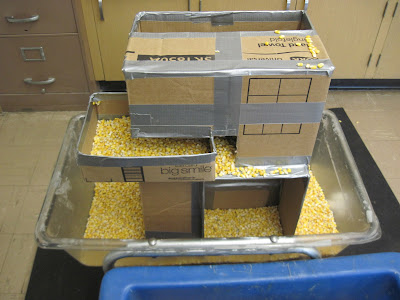The first view is from one end of the larger, blue sensory table.
Note that there is one large box in the foreground with a big, wide opening.
From the other side of the blue table, you can see an additional five boxes embedded in or attached to that large box.
The red cylinder in box #3 is an embedded coffee can. The coffee can is the same depth as the box, so it rests firmly on the bottom of the table. The coffee can is taped securely into the box.

Duct tape is spread over the edges. Three cuts are made in the tape to be able to fold the tape over the lip of the coffee can.
The third view shows a set of Boxes in Boxes in a second, smaller sensory table right next to the blue table. This set is made from five boxes. The set includes an interesting component: a cantilevered box extending out from the middle of the other boxes.
#4 under Dimensions and Elements highlights creating spaces over, under, around, and through the table for exploration. Axiom #2 states that children will explore any and all spaces created by the apparatus. Let's see what that means for the Boxes in Boxes apparatus.
There are spaces "over." Children operate in all the spaces formed by the tops of boxes. By their very nature, tops of boxes are "over" spaces---sometimes over multiple spaces.
There is another kind of "over," too. This is illustrated by child exploring the corn in a cantilevered box that juts out and over in the middle of the apparatus. Though some corn is under the corner of the box, there is still plenty over the apparatus and the table itself.
There is definitely "under."


There is a lot of "in."

There is even some "through."
"Around" cannot be illustrated with one picture. It is best to think of "around" as the children moving around the apparatus appraising the spaces in terms of suitability for their operations. Watch.
BOXES IN BOXES from Thomas Bedard on Vimeo.
At the very beginning of the video, did you see the child's head bob up and down as he was checking out the spaces? After pouring some corn into the cantilevered box, he begins to move and takes a quick check of other spaces. At the same time, there is another child on the opposite side checking out the spaces. And as you see, they are both moving. What you don't see is that they actually move around the table. And around and around….If you are interested in a similar apparatus, check out this post and this post. The apparatus featured in those posts are larger and much more closed.
The corollary to Axiom #2 asserts: the more spaces, the more exploration. I will leave it to your imagination how much exploration eleven boxes with multiple holes and openings on multiple levels provokes.




















